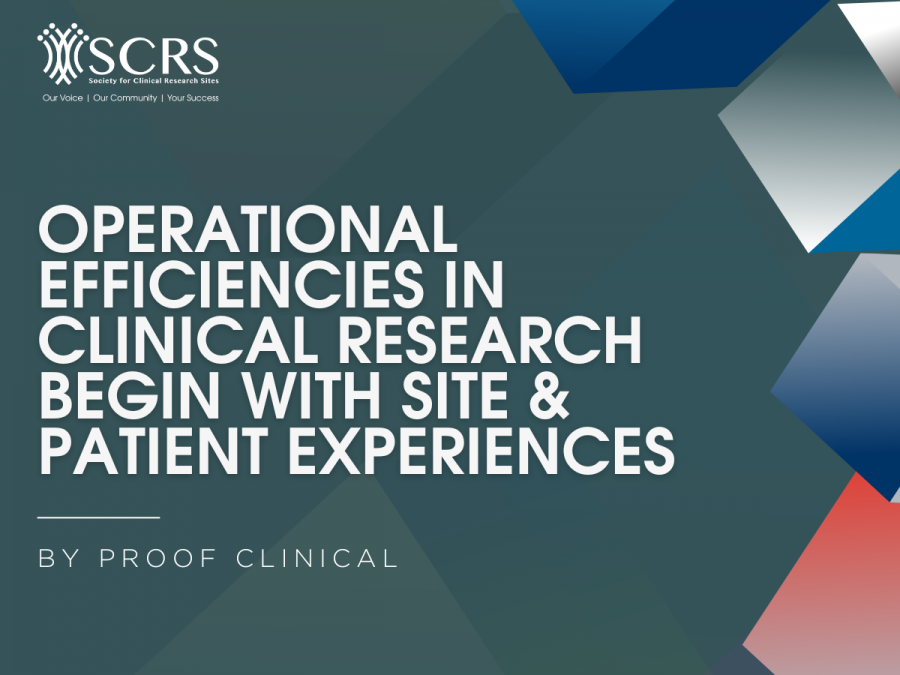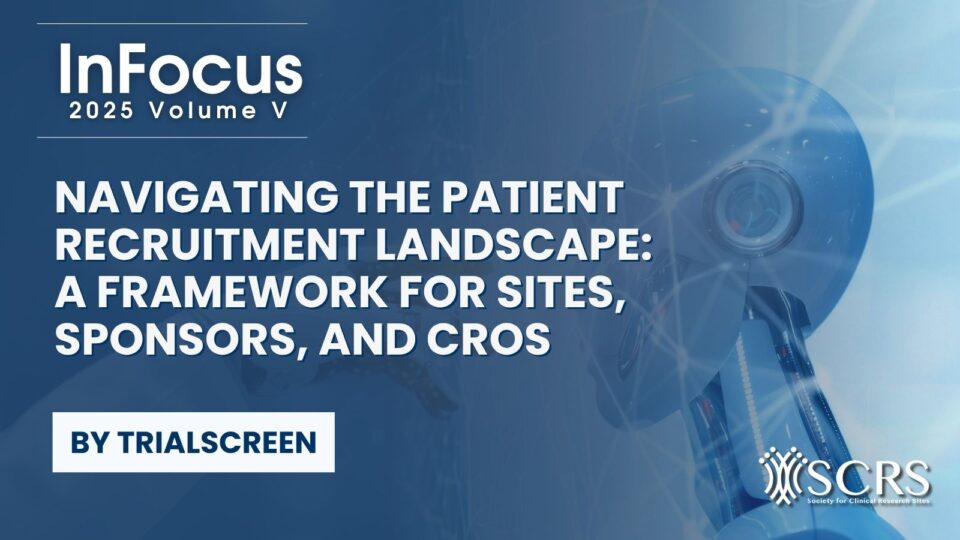Operational Efficiencies in Clinical Research Begin with Site & Patient Experiences

By Queen Adaugo Ohandjo, Ph.D, MSCR Founder, Proof Clinical Research
Site & Patient Experience Advocate
Operational efficiencies, when properly leveraged, are a key opportunity in clinical research to resolve bottlenecks in all aspects of clinical operations. For example, there are still operational inefficiencies with site-managed data synchronization, thus causing a break or bottleneck in the feedback chain. Fortunately, many technology partners are already doing their part in prioritizing operational efficiencies.
Here at Proof Clinical Research, the operational efficiencies that we have experienced while advocating for patients and sites in the clinical industry are centered around patient data capture, shared investigators platforms and the digitalization of clinical trial documents like eProtocol, eConsent and eISF. The impact of these solutions and systems has helped to transcend the clinical research landscape, but a full-scope transformation is necessary if we are to create and sustain an inclusive and equitable clinical industry that transcends time.
Establishing Efficient Clinical Workflows
According to site and patient feedback received from our grassroots efforts, the consensus is that operational efficiencies should be defined by clinical workflows that enhance the survivability and successful outcome of clinical trials managed by site personnel.
The Clinical Trials Operations Branch in the Office of Clinical Research at the NIMH developed a framework for assessing the operational complexity of clinical trials. This complexity is based on potential operational challenges presented in the planned research.
According to NIMH, the goal of the assessment is to evaluate the operational aspects of a clinical trial in synchronization with the study team’s resources and capacity. In addition to successfully enrolling eligible participants in a study, a clinical trial relies on having enough retention of participants through study completion to have the statistical power to answer the proposed research questions.
The Office of Clinical Research at the NIMH highlighted that there are numerous factors that contribute to study dropout and follow-up completion rates. Some factors are controlled by the study team while others factors are controlled by a population that is more clinically unstable than expected.
The life cycle of clinical operations begins with patient engagement. All stakeholders should be mindful of what is being asked of clinical study participants in terms of the frequency and complexity of clinical procedures. This is a necessary step to assess if participants will be willing to enroll and remain engaged for the duration of a study.
Data Collection & Management
Another aspect of the operational evaluation relates to data collection, coordination, and management. A feedback loop is necessary in order to eliminate bottlenecks and redundancy. Ultimately, attracting and retaining participants in the research of new medicines, therapies and interventions are becoming an industry and non-industry-wide effort. We need not be complacent about integrating solutions from other industries in order to reach a wider audience whose attention and interest in clinical trials have been clouded with horrific and non-ethical experiences.
Subsequently, a comprehensive operational review allows study teams to make more informed decisions about whether a team has the staffing, resources and procedures in place to run a trial successfully from inception. This informed decision should be substantiated with real-time reports from integrated and unified clinical platforms. By reviewing factors that contribute to operational efficiencies, sites and patients are better positioned to enhance the stewardship of the clinical trials it supports and participates in.
The digitalization of clinical trial start-up processes into an integrated or unified clinical environment has resulted in favorable outcomes, however much more is needed to ensure a successful and positive patient recruitment experience. Unified platforms that connect patients, sites, sponsors, and partners in a secure and scalable cloud environment by reusing, recycling and standardizing data ultimately help to bring life-changing medicines to those who need them most. The objective is not unified vs integrated; the objective should be solutions that integrate all the functionalities required for a clinical study from planning to closeout. This includes, but is not limited to:
- a solution that facilitates hybrid, on-site, off-site and remote teamwork.
- a solution that is geo-regulatory compliant.
- a solution that is adaptable to epi-financial outliers.
- a solution that is built on intelligent reporting capabilities.
- a solution that incorporates natural language processing and cultural nuances.
- a solution with synchronized feedback into clinical workflows.
Enabling Trial Diversity
Furthermore, when utilized appropriately, we know that technology can be instrumental in accessing and managing a diverse patient representation in trials, but there are still lessons to be learned regarding how to better serve sites and patients in an inclusive manner.
Discussions with patients and sites inform us that the digitization efforts have to expand beyond our clinical industry and begin to collaborate across non-clinical industries that share similar outcomes and patient profiles with clinical trials teams across the globe.
The push for good medicines begins with a better understanding of the patient’s lifestyle, site-patient relationship, patient cultural awareness and community-centered participation. Partnership with communities and diverse patient representation are critical to earning and maintaining trust in the clinical research and healthcare industry.
When diversity and inclusivity have been met, then ensuring positive community impact and equitable uptake of new medicines, therapies and interventions should be the primary objective of all clinical trial stakeholders. A community-centered participatory research (CCPR) approach that intentionally accounts for the social and local needs of engaged partners (patients and sites included) will be necessary to enhance and create solutions that prioritize operational efficiencies in a non-biased manner.
A patient-recommended CCPR blueprint includes solutions integrated with:
- Cultural sensitivity & specificity: applications that enable and promote positive and effective interaction with diverse cultures.
- Knowledge training: applications that focus on providing patient and site partners with the content and process know-how needed to retain participants’ full and robust engagement in clinical research activities.
- Supportive measures: applications that provide facilitating tools, devices, platforms, or materials that support full engagement in clinical research activities.
Clinical Research Sites & Patients Drive Intentional Changes
There is a huge opportunity for site and patient advocates to educate stakeholders on what works well in the environment and community where research is being conducted.
Sites are the epicenter of the clinical trial process. As a result, there is an opportunity for sites to drive intentional changes into sustainable and successful clinical operations. Site feedback on targeted outreach, opportunity marketing, inclusive applications, and participant selection processes creates a valuable atmosphere whether in an offsite, on-site, remote or hybrid setting. Site and patient advocates streamlining the message to all stakeholders through channels (such as advocacy channels, social network channels, and peer-to-peer channels) are necessary to reach underrepresented populations.
In summary, there is a huge opportunity for site and patient advocates to educate stakeholders on what works well in the environment and community where research is being conducted. By working closely with advocacy and existing social network groups, key stakeholders begin to build trusted pillars within the community and engage with patients in the contexts that are familiar to them thus enhancing operational efficiencies and establishing clear practices for how the future of clinical research should be operationalized.
For example, during the planning stage, the utilization of mobile and/or web applications that identify and test potential community outreach strategies, and develop peer /clinical navigator programs, community-centered practices and support resources should be integrated into unified platforms or serve as a stand-alone add-on. This approach will help identify and test potential operational strategies, identify bottlenecks and mitigate financial losses due to inconsistent forecasts well before millions of dollars are invested in a particular clinical study.
References
Sharon L. Smith, DNP; Galia Siegel, PhD; Ashley Kennedy, PhD. Assessing the Operational Complexity of a Clinical Trial: The Experience of the National Institute of Mental Health. Clinical Researcher—March 2020 (Volume 34, Issue 3)
Elizabeth Cope, Ph.D., M.P.H. Prashila Dullabh, M.D. Michelle Johnston-Fleece, M.P.H. Claudia Grossmann, Ph.D. HSR Resources & Methods Research Ethics & Governance Patient & Consumer Engagement Health Equity. Mar 01, 2022
TransCelerate BioPharma Inc. Seven ways to diversify patient populations in clinical trials. https://www.transceleratebiopharmainc.com/seven-ways-to-diversify-patient-populations-in-clinical-trials/ 08/03/2021
Reeshav Mittal, BDS, CCRA, CCRP. Cloudbyz for Association of Clinical Research Professionals. Unified Clinical Trial Management Systems: What They Are, Why They Matter, How to Choose Them., March 30, 2022



